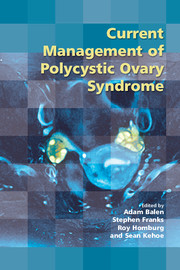Book contents
- Frontmatter
- Contents
- Participants
- Declarations of personal interest
- Preface
- 1 Overview and definitions of polycystic ovary syndrome and the polycystic ovary
- 2 Genetics and pathogenesis of polycystic ovary syndrome
- 3 Ethnic variations in the expression of polycystic ovary syndrome
- 4 Quality of life for women with polycystic ovary syndrome
- 5 Insulin resistance, the metabolic syndrome and polycystic ovary syndrome
- 6 Management of polycystic ovary syndrome through puberty and adolescence
- 7 Long-term health risks of polycystic ovary syndrome
- 8 Approaches to lifestyle management in polycystic ovary syndrome
- 9 Management of obesity in polycystic ovary syndrome, including anti-obesity drugs and bariatric surgery
- 10 Definition of hyperandrogenism
- 11 Treatment of hyperandrogenism in polycystic ovary syndrome
- 12 Choices in the treatment of anovulatory polycystic ovary syndrome
- 13 Predictors of ovarian response to ovarian stimulation: progress towards individualised treatment in ovulation induction
- 14 Surgical management of anovulatory infertility in polycystic ovary syndrome
- 15 The role of insulin-sensitising drugs in the treatment of polycystic ovary syndrome
- 16 The role of in vitro maturation of oocytes for anovulatory polycystic ovary syndrome
- 17 Acupuncture and/or herbal therapy as an alternative or complement for relief of polycystic ovary syndrome-related symptoms
- 18 Consensus views arising from the 59th Study Group: Current Management of Polycystic Ovary Syndrome
- Index
15 - The role of insulin-sensitising drugs in the treatment of polycystic ovary syndrome
Published online by Cambridge University Press: 05 July 2014
- Frontmatter
- Contents
- Participants
- Declarations of personal interest
- Preface
- 1 Overview and definitions of polycystic ovary syndrome and the polycystic ovary
- 2 Genetics and pathogenesis of polycystic ovary syndrome
- 3 Ethnic variations in the expression of polycystic ovary syndrome
- 4 Quality of life for women with polycystic ovary syndrome
- 5 Insulin resistance, the metabolic syndrome and polycystic ovary syndrome
- 6 Management of polycystic ovary syndrome through puberty and adolescence
- 7 Long-term health risks of polycystic ovary syndrome
- 8 Approaches to lifestyle management in polycystic ovary syndrome
- 9 Management of obesity in polycystic ovary syndrome, including anti-obesity drugs and bariatric surgery
- 10 Definition of hyperandrogenism
- 11 Treatment of hyperandrogenism in polycystic ovary syndrome
- 12 Choices in the treatment of anovulatory polycystic ovary syndrome
- 13 Predictors of ovarian response to ovarian stimulation: progress towards individualised treatment in ovulation induction
- 14 Surgical management of anovulatory infertility in polycystic ovary syndrome
- 15 The role of insulin-sensitising drugs in the treatment of polycystic ovary syndrome
- 16 The role of in vitro maturation of oocytes for anovulatory polycystic ovary syndrome
- 17 Acupuncture and/or herbal therapy as an alternative or complement for relief of polycystic ovary syndrome-related symptoms
- 18 Consensus views arising from the 59th Study Group: Current Management of Polycystic Ovary Syndrome
- Index
Summary
Introduction
Insulin-sensitising agents are frequently used in the treatment of women with polycystic ovary syndrome (PCOS) but, to date, the results have fallen short of expectations. Despite their limited benefits, these drugs are widely used in PCOS, and they are probably overprescribed. Insulin-sensitising agents are a class of drugs that work primarily or in part by improving peripheral insulin sensitivity to lower insulin levels and, ultimately, to lower circulating glucose levels. The classic example is the thiazolidinediones (pioglitazone and rosiglitazone). Given the intense endocrine interaction of tissues involved in glucose homeostasis, drugs that target one organ or function often have cross-over benefit on other aspects of glucose homeostasis. For instance, the biguanides primarily suppress hepatic gluconeogenesis but also exert some peripheral insulin-sensitising action, and it is this action that has led to the use of metformin in women with PCOS.
While insulin-sensitising agents improve many symptoms and presenting complaints of women with PCOS, they do not represent a cure. They exert varying effects depending on the condition being treated. In many situations, there is no or only minimal benefit. The risk/benefit ratio for their use must thus be examined for each indication. This chapter explores the use of insulin sensitisers, primarily metformin, for varying indications related to PCOS and discusses the evidence to develop a risk/benefit ratio for their use. These drugs were developed to treat type 2 diabetes and have been adapted as treatments for the symptoms of PCOS.
Keywords
- Type
- Chapter
- Information
- Current Management of Polycystic Ovary Syndrome , pp. 173 - 184Publisher: Cambridge University PressPrint publication year: 2010

